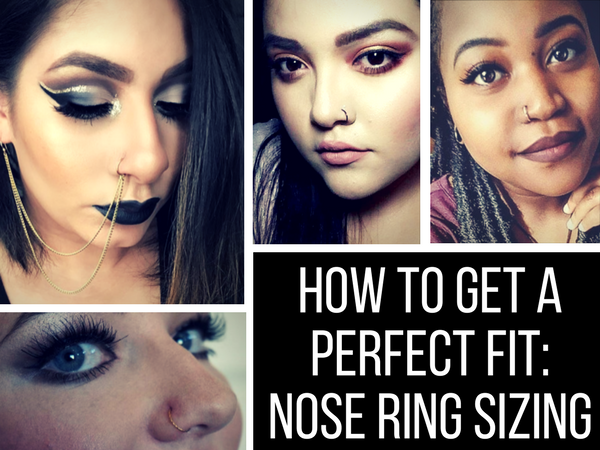Piercings Gone Wrong. We've all seen it. We all hope it doesn't happen to us. This guide can help! Keep reading for:
- Why you might be having a reaction to your jewelry
- Some details about the metals & materials that Body Candy uses
- Which material may be right for you (whether your skin is metal sensitive or not)
Allergic Reactions
IF:
- You are experiencing mild itching & redness or more serious symptoms like swelling & throbbing
- Your piercing is migrating away from your jewelry
THEN:
- You are probably experiencing an allergic reaction!
- Allergens have been introduced to the body through your piercing
- These reactions are common
Some people can wear all kinds of jewelry. Others find allergic & irritated reactions common or even develop allergies later in life
To prevent reactions and sensitivities in the first place we suggest considering one of the following materials for your next body jewelry purchase:
14k Gold
PTFE
Bioplast
Solid Titanium
- Creating alloys composed of gold and other metals gives the ability to craft more wearable, durable pieces of jewelry than gold alone. Each listed karat weight (k) is a reference to the percentage of pure gold your jewelry contains.
- Solid gold jewelry is hypoallergenic and a reliable option for many people with metal sensitivities
- The lightweight flexibility of PTFE provides maximum comfort as it flexes with tissue instead of against it. This amazing, nonstick material can substantially reduce healing time in new piercings, piercings grouped close together, and piercings that have changed with your body over time.
- One of the most exciting uses of PTFE is the popular pregnancy belly ring style that fits your growing tummy! PTFE is autoclavable and hypoallergenic. This material is an excellent choice for people who struggle with sensitivities and allergic reactions to metals.
- If you’ve noticed your jewelry irritates your piercing or if you know for certain you have a nickel allergy then Bioplast may be right for you.
- Bioplast is not metal and the material can be heat sterilized, making it safe for healing swollen or infected piercings and the safest option for allergy sufferers or anyone who doesn’t want to take any chances on metals.
- Grade 23 titanium is high quality and is used for solid titanium pieces which are composed of an alloy of pure titanium and other metals or elements.
- The “grade” listed with titanium products is a reference to the exact composition and oxygen content of the metal. This type of titanium can be heat sterilized and is considered hypoallergenic so its a great choice if you are prone to allergic reaction.
When it comes to the metals and materials used to create your body jewelry there is always new and changing information. At Body Candy we do our best to help you make an informed decision but we ALWAYS recommend that you ask your own trusted piercer for advice specific to you.
So, you've never had an allergic reaction? Your piercings are healed and you've worn a variety of jewelry materials. You can wear the materials listed above, but also some others listed below:
Sterling Silver
Acrylic
316L Surgical Grade Stainless Steel
Anodized Titanium
Gold Plated
- Sterling silver–even when combined with other metals–is soft enough to scratch, creating nicks that can be a trigger for bacteria.
- Silver tends to oxidize when it comes in contact with body tissues or fluids and the result (tarnish!) is not good for your piercing.
- Do not wear sterling silver jewelry in unhealed body piercings or if you are prone to allergic reaction!
- “Acrylic” refers to varieties of plastic like lucite and plexiglass that are super light and great for larger gauge piercings.
- Acrylic jewelry comes in every color and print you can imagine but is much easier to break or shatter than other materials.
- Bending, heating, and dropping are death for acrylic jewelry which means Acrylic can not be sterilized and is not a good choice for people who are prone to allergic reactions or for use in unhealed body piercings.
316L Surgical Grade Stainless Steel:
- This high shine, no frills marvel is the perfect combo of function and anti-fashion thanks to its colorless, simple style that makes it the go-to material for ever-changing trends. If you are prone to allergic reaction and find that you cannot wear “plain” metal body jewelry this may not be right for you.
- Titanium can be used for both solid titanium pieces as described above or as an outer coating for items plated in titanium. Like gold plated jewelry, anodized titanium pieces are composed of a hard metal core like surgical steel and a high shine outer coating: in this case, titanium. This allows for a variety of bright, colorful jewelry. Body Candy is generally able to list the base metal for anodized and plated jewelry. If you are prone to allergic reaction you should choose pieces with a base metal that is right for you.
- When an item is listed as “gold plated,” the item is not solid gold. The base is composed of a harder metal like surgical grade stainless steel which is coated with a thin layer of lustrous gold for a shining finish. This creates the look of gold but with greater stability and a lower cost. Many people can wear plated items but if you are unable to wear stainless steel body jewelry this may not be a good choice for you.
When it comes to the metals and materials used to create your body jewelry there is always new and changing information. At Body Candy we do our best to help you make an informed decision but we ALWAYS recommend that you ask your own trusted piercer for advice specific to you.
















